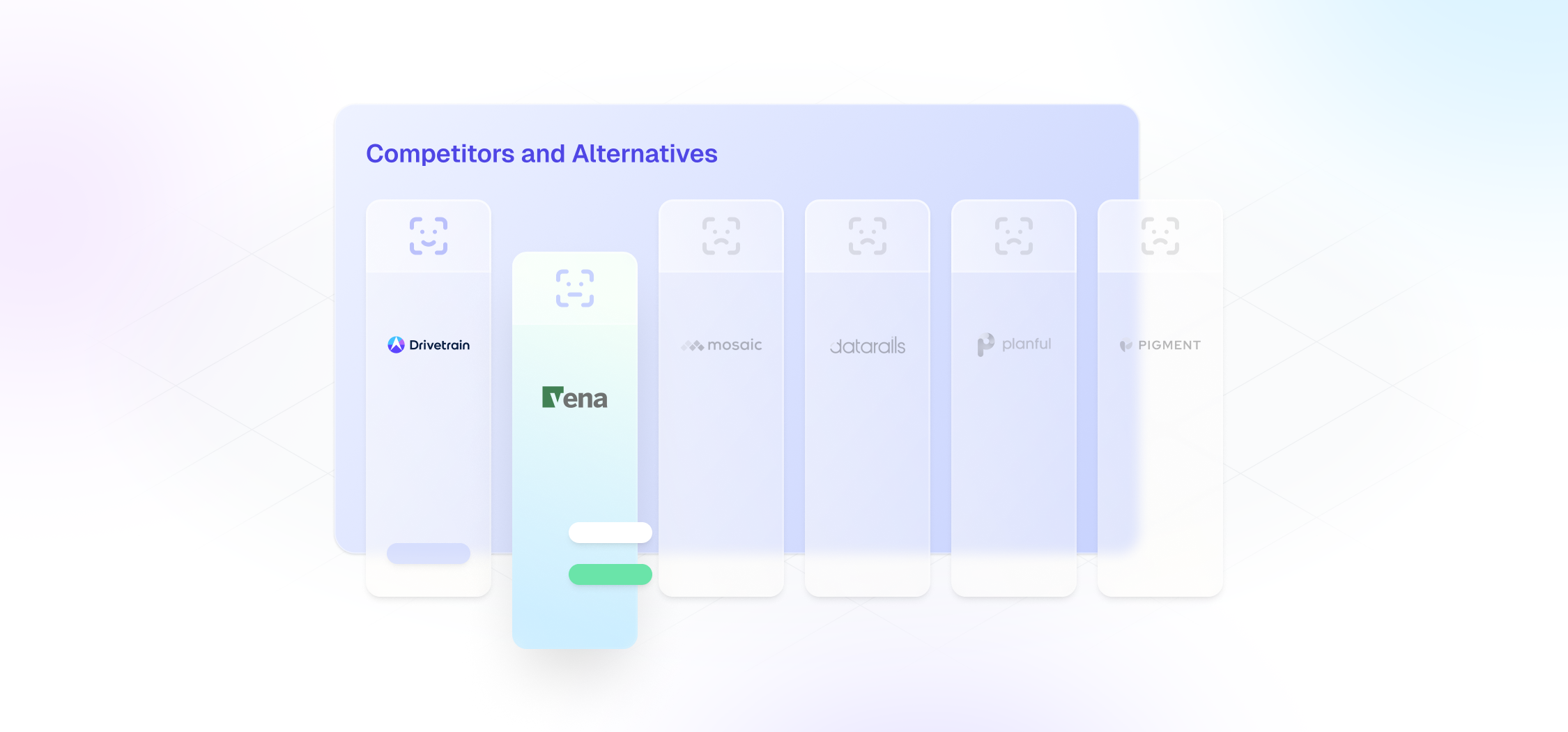This guide will help you evaluate Planful and Vena through the lens of common buyer concerns, such as implementation speed, governance, scalability, and integrations. You’ll get a detailed comparison of both platforms, highlighting their strengths, weaknesses, and best-fit scenarios based on user reviews with practical insights and a clear decision framework to choose the right FP&A solution for your business. We also take a look at Drivetrain, an alternative that addresses where both Planful and Vena fall short.
Planful and Vena are popular tools, but are they right for your business?
Well, it depends.
Choosing between Planful and Vena boils down to comparing implementation speed, model ownership, scalability, and user experience. As you make this comparison, you’ll see that choosing between these two platforms will require some trade-offs between modeling capabilities, reporting features, governance flexibility, time-to-value, and total cost of ownership (TCO).
In this guide, our goal is to help mid-market and enterprise buyers understand how Planful and Vena stack up against each other and whether there’s a better alternative out there. We draw insights from user reviews and additional research to help you make the right decision.
Planful: strengths, weaknesses, best fit
Planful is a cloud-based financial performance management platform. It offers a wide range of tools across planning and close, pre-built templates, and AI-assisted tools, which make Planful well-suited for multi-entity and audit-heavy environments.
Most of Planful’s FP&A features are packed into its Planful for Finance suite, which offers continuous and collaborative planning. It helps automate forecasts, run “what-if” scenarios, and model outcomes on demand.
Planful’s AI features include Planful Signals for anomaly detection and Planful Projections for machine-learning-driven forecasts. These features help catch issues before they escalate and identify trends before your competitors do.
In addition to automation, Planful offers built-in audit trails, multi-book reporting (GAAP, IFRS, management, or statutory), and automated eliminations to make month-end close easier.
If you zoom out and look at the big picture, you’ll see that Planful positions itself as more than a planning tool—it aims to be a strategic assistant. It doesn’t just report past data. It unifies that data, automates routine processes, and embeds AI directly into financial workflows to provide you with insights into the future.
Planful isn’t perfect, though. Users note that there’s a steep learning curve for anyone transitioning to Planful from Excel. There’s also some setup and administrative overhead to consider when implementing complex, multi-entity configurations.
What are Planful’s core strengths?
- Breadth across planning and close: Planful offers comprehensive capabilities, covering budgeting, forecasting, consolidation, and reporting to streamline planning and month-end close processes.
- Templates: Reporting templates give users a head start for collecting and visualizing key data.
- AI-assisted features: AI-powered features help users actively monitor data for anomalies and catch trends or issues in a timely manner.
- Value in multi-entity, audit-heavy environments: Planful helps users manage multiple books and compliance across entities, shortening month-end close cycles.
What are users saying about Planful’s downsides?
- Learning curve for non-Excel users: Users report difficulty adapting to Planful’s interface and workflows when switching from Excel.
- Setup and administrative overhead: Implementing Planful for complex, multi-entity configurations requires significant planning and administrative effort.
- Very limited native integrations: Planful only offers 16 native integrations and requires users purchase a third-party integration service (Boomi) to connect with other systems.
- Very high total cost of ownership (TCO): The ongoing need for IT expertise and/or consulting assistance to maintain models and integrations beyond implementation makes it difficult to assess TCO and most certainly increases it.
- Limitations in multi-dimensional modeling: Planful users are limited to modeling in only eight dimensions, which falls far short of the needs of most enterprises.
When does Planful make sense?
Planful makes sense for companies large enough to struggle with multi-entity consolidation and audit compliance, yet small enough to need faster time-to-value than legacy platforms like Oracle and Anaplan can offer.
However, if you’re still managing finances in basic spreadsheets, switching to Planful could be quite daunting and may not be a great fit for companies unwilling to invest much in setup and training during implementation.
Vena: strengths, weaknesses, best fit
Vena is a corporate performance management (CPM) platform. It wraps enterprise workflow, auditability, and a centralized database around native Excel. This means your team can keep their spreadsheets while benefiting from the governance and workflow of a purpose-built CPM platform.
Vena’s Excel-first philosophy drives most of its popularity. If you quickly scan through user and expert reviews, you’ll see words like “tight Excel integration” pop up frequently. Just like Excel, it integrates with various tools in the Microsoft ecosystem, including Teams and Power BI, making it a potentially good option for teams already using the Microsoft ecosystem.
Beyond its Excel-like interface and Microsoft integrations, Vena can automate budget cycles, consolidate financials, and apply business rules (such as approval hierarchies, standard formulas, etc.) while maintaining complete traceability of every change and approval.
Vena isn’t exactly a no-brainer, though. While it can automate budget cycles, it actually undermines the budgeting process in some ways. For example, users note that the platform can be intimidating and difficult for non-finance users. This, combined with the fact that Vena requires stakeholders to have a Vena license in order to edit reports, makes collaboration across departments—a must-have for effective budgeting—not only complex but quite costly.
One of the biggest issues users report are the costs associated with implementation. Getting up and running in Vena takes around five months, on average, and several reviews call out the need for a comprehensive implementation plan to fully address all the inherent complexities and governance prior to onboarding.
External consultants are often needed to get the architecture and processes configured correctly, right. Once up and running, users also complain that it requires a steep learning curve when building new financial models, and can run into performance issues when uploading or running large or complex workbooks. Issues like these as well as prolonged implementations can prompt users to begin exploring Vena alternatives.
What are Vena’s pros?
- Excel-native experience: Vena’s Excel interface helps to ease adoption for teams that prefer working with spreadsheets.
- Responsive support: User reviews on various platforms appreciate Vena’s responsive support.
- Integration with Microsoft 365: Vena offers deep integration with Microsoft tools, including Excel, Teams, and Power BI, making it a good fit for companies with existing investments in the Microsoft ecosystem.
What are Vena’s cons?
- Advanced builds usually require external consultants: Complex modeling and workflow setups require external consulting help, leading to longer implementation times and higher costs.
- Scalability and governance challenges: Some users mention performance slowdowns and model management complexity in large-scale deployments.
- Spreadsheet dependency: While Excel integration is a strength, it can also perpetuate spreadsheet-based control risks, like accidental formula edits or version control issues, if governance isn’t enforced.
When does Vena make sense?
Vena makes sense for finance teams at mid-sized to enterprise companies who are comfortable with Excel but need more structure. As one user points out in a G2 review, “What I like most is how it works with Excel instead of replacing it.”
Vena’s strength lies in combining the familiar Excel interface with enterprise-level workflow, data centralization, and auditability. “Enterprise-level” is the keyword here. If you’re a small company or team, Vena will likely be overkill for your needs.
Planful vs. Vena: direct feature and experience comparison
Here’s the preview: Overall, Vena is the more powerful solution.
But let’s dig deeper. Both Planful and Vena are powerful and promise faster closes, better forecasts, and fewer late nights staring at Excel sheets.
Vena has an edge because it meets finance teams where many of them already live—in spreadsheets. Vena feels like a natural extension of the Microsoft ecosystem and offers over 100 integrations (compared to Planful’s 16), potentially making it easier to plug into your existing tech stack.
The Excel-like interface and its integrations are part of the reason why Vena scores higher on ease of use (8.6 vs 8.1) and setup (8.2 vs 7.3). It essentially makes onboarding feel less like a system migration and more like a workflow upgrade.
If you look at the table below, you’ll see Vena scores higher than Planful across the board except for time to ROI. Even there, the gap isn’t too wide.
On the other hand, Planful focuses on structure and governance. If your company operates in an audit-heavy environment, Planful might help you minimize errors and enforce consistency.
.png)
Where both Planful and Vena fall short for dynamic finance teams
Planful and Vena both fall short across various areas that are important to finance teams today. Let’s take a closer look at how.
Dependence on consultants slows time to value
Both Planful and Vena take multiple quarters to implement. Users of both platforms frequently express concerns about difficulty with integrations, evolving scope, and the need for expert intervention.
A Planful reviewer says, “The implementation of Planful is taking too long and is being drawn out longer than it should.” Many Vena customers have a similar experience. Another Vena customer echoes, “Implementation times can be too long. We have done one and are now doing another implementation, but it’s a very time-consuming activity.”
This dependence doesn’t go away after go-live, either. Both platforms often require help from superusers or external consultants to sustain and adapt the models, which can frustrate finance teams, making them question who really owns the system.
Dependence is also a problem for CFOs. Every hour spent on dealing with complex integrations or waiting for professional help inflates TCO and pushes out time to ROI. It essentially ends up hurting your team’s agility—the very thing you expected the platform to improve.
Trade-offs between governance and performance
How fast your model performs is just as important as what your model is capable of. For both Planful and Vena, the balance between governance and high performance is a friction point.
Performance drags when you deploy large, complex models, especially in high-dimensional scenarios or with many simultaneous users. As one Planful user highlights, “The performance bottlenecks only seem to arise when the dimensionality of models exceeds a certain threshold.” That threshold appears to be Planful’s limit of eight dimensions.
Vena has similar performance issues when processing large datasets. According to a Vena user, “The biggest issue about Vena from my point of view is the lack of some data operations and computational efficiency. Sometimes you feel limited in what you can do.”
Compromise in performance is partly attributable to governance. Planful is a solid platform for multi-entity and compliance-heavy companies because it offers strong control and governance, but that structure can feel pretty rigid when your team wants to do an ad-hoc analysis or rapidly iterate.
On the other hand, Vena’s Excel-native front end offers more flexibility and a somewhat shorter ramp-up for teams familiar with spreadsheets. But without tight governance, continued use of spreadsheets and their vulnerabilities poses risks like version sprawl and shadow models.
Limited integrations increase maintenance burden
Fewer integrations might not sound like a major problem right off the bat, but it’s a key driver of TCO because it increases reliance on consultants.
Integrations aren’t exactly a great selling point for Planful. It only offers a handful of integrations, which can leave users with more manual work than they expected once invested.
One Planful user points out this shortcoming, “Currently, Planful is not connected to our ERP system, which means we still need to upload a significant amount of data manually. This adds extra steps to our workflow and limits the potential for real-time updates.”
Vena offers a much larger integration library, but it has its own set of challenges. Users often report inconsistent sync times between integrated systems. One user noted this issue and its consequences, saying, “The delay of a few hours for data synchronization between Vena and the source systems can cause some disparity in the reports derived from it.”
Things get even more complicated when source systems (like your ERP or CRM) or the financial system’s table structure change. Updating your FP&A platform’s import logic to accommodate these changes creates fragility and unpredictable schedules.
These issues corner teams to reach out to consultants and experts. The result? Inaccuracies creep into the models, performance lags, TTV takes longer and TCO increases.
How Drivetrain outperforms Planful and Vena
Drivetrain is an AI-native FP&A platform that offers a strong alternative that addresses almost all the gaps in both Planful and Vena. With Drivetrain, users achieve faster time-to-value, have a lower TCO, and don’t struggle with the performance issues that Vena Planful and Vena users do.
Faster time‑to‑value with finance‑owned models
Drivetrain gets your team live faster without external consultants. The reason is pretty simple. Drivetrain deployments follow a milestone-based plan that prioritizes quick wins—getting core forecasting and reporting live first, then expanding to advanced models. This shortens time-to-value from multiple quarters to a few weeks.
Once models are live, your finance team owns them. Drivetrain is designed for ease of use and finance-first modeling to allow your analysts to modify assumptions, build scenarios, and adjust drivers without needing third-party support. This translates to faster iteration and greater business agility.
A powerful platform built for scale and unparalleled agility
With a powerful calculation engine under the hood, Drivetrain’s performance excels where both Planful and Vena struggle. Drivetrain’s advanced, multi-dimensional modeling engine supports multi-entity structures, scenario planning, and high concurrency without trade-offs between performance and governance.
With Drivetrain, you get built-in, finance-ready reporting packs that come with role-based, shareable views that eliminate the constant detour back to Excel. Moreover, governed metric definitions and a shared catalog ensure that all involved teams are on the same page.
This scale and governance don’t come at the cost of control or agility either. If anything, you get:
- More control: Every change in Drivetrain carries its own audit trail, approval flow, and version control. This means ownership and context are always clear.
- Deeper insights more easily: Drivetrain’s BI-friendly handoffs preserve data lineage and definitions, making deeper analysis quicker and easier.
- More agility: Because Drivetrain integrations are designed to be business-manageable, you can ensure reports stay current even when upstream systems evolve.
Easy, robust integrations ensure resilient data pipelines
Drivetrain connects natively with more than 800 systems, covering all major categories like ERP, CRM, HRIS, and BI tools that your team depends on. This helps speed up implementation.
In contrast to Planful and Vena, which often rely on consultant-built integrations that break when upstream systems change, with Drivetrain, you’re less dependent on consultants and vendor services, thanks to clear patterns for handling new entities, fields, or schema updates. Drivetrain’s native data connectors are plug-and-play, meaning you don’t need middleware or third-party assistance to work with them, and most can be installed and configured in a matter of minutes.
.png)
A decision framework for CFOs
We’ve talked quite a bit about three FP&A platforms in this guide. Ingesting all of this information and deciding can seem overwhelming. Below, we offer a decision framework with the primary parameters you’ll need to evaluate to make the best choice for your business, without getting lost in the details.
Team size
- Planful: Best suited for mid-to-large finance teams with dedicated FP&A analysts and IT support.
- Vena: Fits finance teams already fluent in Excel; scales across departments with some governance discipline.
- Drivetrain: Works for enterprise teams and lean or scaling teams that want end-to-end ownership without depending on IT or consultants.
Technical resources
- Planful: Often requires IT or implementation partners for setup and ongoing model updates.
- Vena: Easy adoption for Excel users, but requires continuing expert oversight for complex builds and model maintenance.
- Drivetrain: Designed for finance ownership: No-code model management, guided setup, and easy, self-service integrations.
Complexity and governance
- Planful: Strong governance and audit features, but can feel rigid in dynamic planning cycles.
- Vena: Flexible modeling, but spreadsheet control risks can surface at scale.
- Drivetrain: Combines auditability with agile modeling; scales across multi-entity, high-frequency scenarios.
Integration depth
- Planful: ~16 native connectors; others require middleware or custom builds.
- Vena: 100+ integrations, but maintenance risk increases with spreadsheet dependence.
- Drivetrain: 800+ resilient, finance-ready integrations that adapt automatically to source-system changes.
Best for:
- Planful: Effective for mature finance organizations with stable processes.
- Vena: Effective for growing teams that need to standardize their budgeting and reporting.
- Drivetrain: Ideal for fast-growing mid-market companies and enterprises that value speed, scalability, and the agility that comes with finance-first FP&A.
Choosing your FP&A partner
Drivetrain, Planful, and Vena each bring clear strengths to the table, but they’re built for different realities.
Planful is built for mature, process-driven companies operating in complex, multi-entity environments that prioritize structured close processes. Its rigid governance also serves organizations in audit-heavy industries that impose strict regulatory compliance.
Vena is built for teams that are reluctant to give up Excel and whose needs have expanded beyond the limits of spreadsheet-based FP&A. Like Planful, it also imposes some governance overhead and because it requires Excel, also comes with some extra work in terms of version-control.
Drivetrain offers a comprehensive platform that serves both of these realities to give you the best of both worlds. Drivetrain provides enterprise-grade security and is built for highly complex FP&A, with the ability to easily automate data consolidation from multiple entities, departments, or subsidiaries into a single platform to speed up your financial close and can simplify even the most complex consolidation, including the management of intercompany eliminations and foreign exchange (FX) accounting easy.
Drivetrain also offers unparalleled ease of use with a spreadsheet-inspired UI that feels familiar to finance teams and designed to deliver scalability, control, and agility. For businesses currently bumping (or slamming) into the limitations of spreadsheet-based FP&A, Drivetrain provides everything they need to, once and for all, say good-bye to Excel and all its inherent issues.
If you’re a mid-market company or enterprise looking for an FP&A platform you can implement within weeks, not months, with robust integrations to connect all the systems you need right out of the box and robust, finance-first modeling, Drivetrain should be at the top of your list.

Book a demo today to learn more about how Drivetrain could be the next, best business decision you can make.
Frequently asked questions
Planful requires more upfront structuring and setup time, which pushes time-to-value further out. In comparison, Vena usually offers a faster ramp-up for teams already comfortable with Excel because its Excel-native interface reduces learning time and the need for major change management.
However, even tools rated highly for ease of use or implementation stumble when underlying systems and data inputs aren’t stable. As one VP of Finance put it in a Reddit post, “The ROI on a budget/forecasting platform is going to be largely based on the quality of the inputs. Too many companies pay money for a great forecasting tool but don’t have the other systems in place (CRM/accounting/etc) to a degree that allows them to utilize the forecasting tool.”
It’s important to note that neither Planful nor Vena is optimized for fast implementation, especially in high-pressure settings. That’s where Drivetrain excels. Unlike Planful and Vena, which typically require expensive external consultants and several months to implement, Drivetrain gets finance teams up and running in 4-6 weeks with its focus on milestone-based implementation and defined quick-win scope, which translates to faster time-to-value.
Both Planful and Vena require roughly five months to implement. However, there’s often a need for extended testing, data cleanup, change management, and external consultants, which can drag out time-to-value.
In contrast, Drivetrain is built to shorten that runway with a milestone-based rollout, predefined quick-win scope, and an extensive integration library, making implementation times measurably shorter.
While migration can be a painful process, Drivetrain reduces that burden with structured migration support, making the transition faster and less disruptive.
Drivetrain minimizes friction during migration with:
- High-touch support
- Dedicated customer success manager
- Comprehensive knowledge base
- Self-guided training hub
Performance scale is heavily influenced by how many dimensions a system supports, how the model is designed, and how many contributors work in the system concurrently.
Planful promotes “unified models, scenarios, dimensions, data sets, and calculations,” but in practice, the platform is limited to just eight dimensions. The product documentation recommends converting high-dimensional sets into attributes, which appears to be a workaround to avoid performance issues.
A Reddit user shares that this is a major practical limitation, saying, “When I used Planful, the big hang-up was once you’re out of dimensions, you’re out, so we always tried to keep one in reserve.”
Vena starts with eight standard dimensions in its best-practice models wizard, but lets you add more. That means it may scale better than a fixed eight-dimension system, but the underlying architecture remains more spreadsheet-inflected and may require substantial custom design to manage large, high-concurrency models.
By contrast, Drivetrain is designed from the ground up for scale. It supports complex, multi-entity architectures, high concurrency, scenario-rich modeling with unlimited dimensions, all while maintaining governance and performance. If your team expects to require many dimensions, large data sets, and many simultaneous users, Drivetrain is the perfect fit.
Planful and Vena are just two of the many AI-powered FP&A tools on the market today.
Planful’s AI features include AI-powered forecasting, risk detection, and natural language queries, with a focus on improving financial planning processes. On the other hand, Vena integrates AI through Vena Copilot and relies on Microsoft Azure’s capabilities to provide AI insights and facilitate AI-assisted report generation and trend analysis.
Drive AI puts Drivetrain in a different league altogether. Drivetrain is an AI-native platform with features built into its core platform to support autonomous FP&A workflows, including real-time AI-powered forecasting and scenario planning, and anomaly alerts based on machine learning (ML).
Not necessarily. Excel familiarity can help teams ramp up quickly, especially for broad budgeting or reporting tasks. But, where Vena is concerned, the familiarity benefit is often outweighed by version sprawl, lack of centralized control, or higher risk of spreadsheet-based errors when scaling the platform or managing compliance.
Drivetrain is a Vena alternative that makes it easy for finance teams to eliminate their dependency on Excel with an Excel-like formula syntax and a user-friendly interface, while at the same time, providing an architecture that enforces governance and maintains audit trails. These factors, along with Drivetrain’s helpful support team and self-training resources, help users onboard quickly and steer clear of the inherent limitations of purely Excel-native tools.

.svg)






.webp)



.svg)

